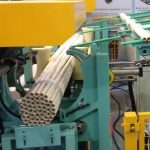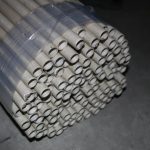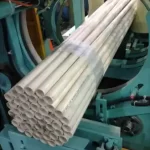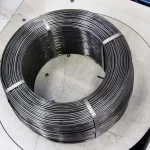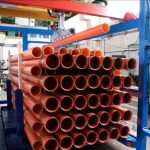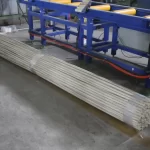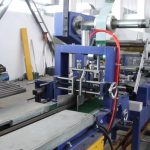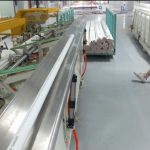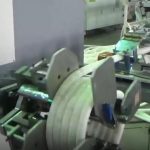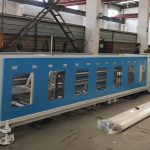plastic pipe bundling and bagging machine
- They typically have a throughput of around 30-200 pipes per minute, depending on the pipe size and machine configuration. Larger pipes have lower throughput.
- The pipes enter the machine through an infeed systemthat centers and orientates them properly using star wheels, guides and air jets.
- Ejection components then eject misaligned or damaged pipes so they don’t disturb the bundling process.
- After alignment, sorted pipes of the same size are gathered into bundles using components like rotating arms, collection flights or star wheels.
- The bundling interval and bundle sizecan be adjusted to suit specific requirements. This is typically done using adjustable cams, wheels or stops.
- Once the desired bundle size is reached, strapping, shrink wrappingor bagging is done automatically using integrated components.
- Strapping machines typically use polyester or polypropylene strapsof specified width and tension.
- Shrink wrappers apply heat-shrink film sleeves that are heated and shrink wrapped around the bundle using heating elements.
- Bagging machines feature bag racks, bag openers and drop chutesto collect the pipes into pre-opened plastic bags.
- Advanced machines have PLC controlsfor automation, while basic models use mechanical timers and counters.
- Overall, these machines are designed for high throughput, consistent bundles and reduced manual labor in pipe bundling operations. They improve efficiency in storage and logistics after pipe production.
- They have adjustable bundle lengths – The bundle size can be adjusted based on the average pipe length in the batch. So pipes of varying lengths within a certain range can still be bundled together.
- They use overflow conveyors – For pipes that are too long to fit in the desired bundle size, overflow conveyors divert them to the end of the line where they can be bundled separately.
- They have multiple bundle sizes – Some advanced machines can produce bundles of 2-3 different size options simultaneously. The appropriately sized bundle is chosen for each pipe based on its length.
- They reject extremely long pipes – For very long pipes that cannot be bundled at all, ejection components reject them before they enter the bundling section of the machine. These pipes are then bundled manually.
- They allow for a pipe length tolerance – The machine is designed to accommodate some variability in pipe lengths within a batch. The tolerance depends on the bundle size and machine adjustments.
In summary, these machines bundle pipes of varying lengths in a given batch through a combination of adjustable bundle sizes, overflow conveyors, multiple bundle options and rejecting extremely long pipes that cannot be bundled automatically. The key is to set appropriate tolerance limits and bundle adjustments based on the application requirements.
Hope this explanation helps! Let me know if you have any other questions about how plastic pipe bundling machines accommodate pipes of different lengths.
